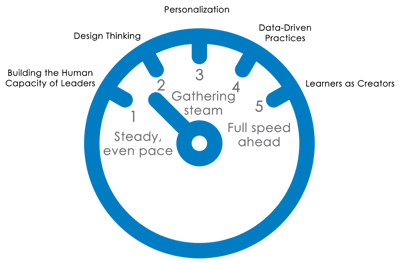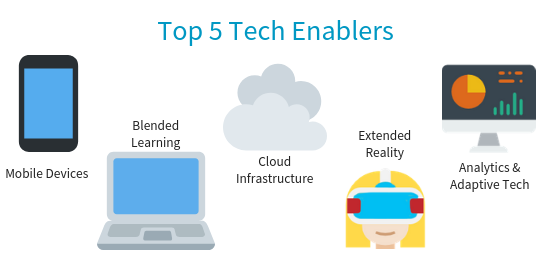The Top 5 Obstacles and Accelerators in Ed Tech
Written by:
Kajeet

Out with the old and in with the new, at least that is how the saying goes. It may be a new year, but educators continue to discuss wanting to adopt more technology and the difficulties in doing so.
However, it is important to understand the obstacles educators face as we move forward into a new year and continue to innovate in education.
Results from a new CoSN survey revealed the top five K-12 hurdles, accelerators, and technology enablers.
If you are a member of CoSN, they encourage schools and districts to submit their examples of any projects or pilots that address overcoming hurdles, accelerate innovation, and/or are tech enablers in action, by January 25, 2019 to potentially be included in future CoSN publications.
Hurdles that Impede Innovation in Education
CoSN facilitated a six-month discussion about emerging technologies as part of their Driving K-12 Innovation initiative.
The group defined hurdles as, “obstacles that make participants slow down, evaluate, practice, and then make the leap to better support teaching and learning.”
The hurdles, in order of least to most difficult to overcome are:
- Ongoing Professional Development: Teachers are not always privy or encouraged to learn new skills.
- Technology and the “Future of Work”: Artificial intelligence, robotics, STEM, and more all impact the skills students need to learn to be successful in the workplace. Read the Kajeet blog on how to prepare your students for success with tech.
- Pedagogy vs. Technology Gap: This hurdle goes hand-in-hand with the ongoing professional development hurdle. Teachers do not always have enough (or any) training on how to integrate technology into their classroom and curriculum.
- Digital Equity: Students do not have equal access to Internet connectivity or technology tools at school or at home. Download the Kajeet “Closing the Homework Gap: A Guide to Increasing Student Success with Home Connectivity” eBook to learn about the impact of this gap and how to help students affected by it the most.
Here at Kajeet, we are dedicated to closing the Homework Gap and helping schools across the nation address the digital equity hurdle. Provide students who lack Internet access at home with Kajeet SmartSpot® devices. These Wi-Fi hotspots connect students to filtered, CIPA-compliant Internet, providing the access they need to get their homework done and keep pace with their more connected peers.
- Scaling and Sustaining Innovation: Schools are frequently challenged to adapt what is working well at a small scale and apply to to an entire school, district, or state level.
|
Do you have students without Internet at home? Ensure digital equity across your school or district by providing Kajeet SmartSpot devices to students. Contact Kajeet today to learn more. |
Is your school or district actively working on solutions to overcome these obstacles? If so, submit your story by January 25, 2019 on CoSN’s page here.
Ed Tech Accelerators
Ladies and gentlemen, start your engines as it’s not all bad news! While there are hurdles to overcome, there are also accelerators, or “megatrends that drive change suddenly and gradually over time.”
These trends are listed in order of speed and intensity. The scale goes from slowest and least intense accelerator to fastest and most intense accelerator.

(Image Source: CoSN)
We’ll start with the first accelerator, which is going at a steady, even pace. (No Indy 500 here.)
1. Building the Human Capacity of Leaders: Leaders who take action to strengthen their professional community at school and opening the door to innovative practices. If you are looking to become a leader at your school, check out the Kajeet blog on five tips for teacher tech leaders.
2. Design Thinking: A strategy to creatively explore and formulate solutions to challenges. IDEO in conjunction with Riverdale Country School in New York has created an entire website (and loads of reading material) dedicated to design thinking examples and the toolkit.We’ll start with the first accelerator, which is going at a steady, even pace. (No Indy 500 here.)
Now we are gathering steam. These accelerator trends drive change faster than the first two trends.
3. Personalization: Schools discover ways to provide learning support at the individual level. Check out ISTE’s site for more information on how to personalizing the learning experience.
4. Data-Driven Practices: Part of personalized learning is using data to meet student’s individual needs. Aside from personalized learning, schools leverage data to make decisions about curriculum, technology investments, and more.
And now we are full speed ahead! This last point is the fastest and most intense accelerator.
5. Learners as Creators: Students don’t have to wait to graduate to change the world. Schools embrace real-world learning experiences with everything from coding in the classroom to makerspaces (or maker buses!) that bring hands-on learning to students.
Lastly, if your school or district is working on any project that exemplifies one of these five accelerators, you can submit your story here.
Technology Tools Driving Innovation
You can’t have technology innovation without one key piece—technology. Tech tools, as defined by the CoSN initiative, are “tools that support smoother leaps over the hurdles and expansive changes in global K-12 education.”
These tech enablers are listed in order of closest proximity to adoption by a majority of educators.
1. Mobile Devices: Hand-held or wearable tools connected to the Internet and drive knowledge consumption or creation.
|
Learn the four best practices for managing student devices in K-12 with the latest Kajeet report! |
2. Blended Learning: This tool combines face-to-face and online interaction, driven by a variety of tools and technologies.
3. Cloud Infrastructure: Virtualized resources that can be hosted remotely, allowing IT teams to no longer need to be physically present in school.
4. Extended Reality: This includes Augmented, Virtual, and Mixed Reality; tools that bring the physical world to a digital one.
5. Analytics and Adaptive Technologies: These are the tools that drive the above accelerators, personalization and data-driven practices.
Whether you are overcoming these hurdles, or accelerating toward ed tech success, it’s critical to ensure teachers are on board and students have the access they need.


